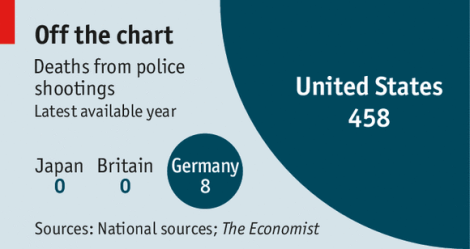Sources: ProPublica, 10 October 2014; Economist 13 December 2014
Links: Deadly Force, in Black and White, America’s Police on Trial, Don’t Shoot
Summary: Although very incomplete due to voluntary self-reporting, available data from the FBI on police shootings indicate that they are much more common in the United States than other developed countries, and that black Americans are more likely to be shot by the police than whites.
Before statistics, a very important quote from ProPublica: “Colin Loftin, University at Albany professor and co-director of the Violence Research Group, said the FBI data is a minimum count of homicides by police, and that it is impossible to precisely measure what puts people at risk of homicide by police without more and better records.”
ProPublica Statistics:
- “Our examination involved detailed accounts of more than 12,000 police homicides stretching from 1980 to 2012 contained in the FBI’s Supplementary Homicide Report.”
- “Vast numbers of the country’s 17,000 police departments don’t file fatal police shooting reports at all, and many have filed reports for some years but not others. Florida departments haven’t filed reports since 1997 and New York City last reported in 2007. Information contained in the individual reports can also be flawed. Still, lots of the reporting police departments are in larger cities, and at least 1000 police departments filed a report or reports over the 33 years.”
- “The 1,217 deadly police shootings from 2010 to 2012 captured in the federal data show that blacks, age 15 to 19, were killed at a rate of 31.17 per million, while just 1.47 per million white males in that age range died at the hands of police.”
- “Young black men are 21 times as likely as their white peers to be killed by police.”
- “44 percent of all those killed by police across the 33 years were white.”
- “The average age of blacks killed by police was 30. The average age of whites was 35.”
- “Black officers account for a little more than 10 percent of all fatal police shootings. Of those they kill, though, 78 percent were black.”
- “White officers killed91 percent of the whites who died at the hands of police. And they were responsible for 68 percent of the people of color killed. Those people of color represented 46 percent of all those killed by white officers.”
Statistics from the Economist:
- According to the FBI, there were 458 “justifiable homicides” by police officers in 2013.
- In the latest available year, there were no fatal police shootings in Japan or Britain, and 8 in Germany.
- The US has “300 million guns and a murder rate six times Germany’s.”
- “This year 46 policemen were shot dead; last year 52,000 were assaulted.”
- “Roughly 29% of Americans shot by the police are black, but so are about 42% of cop killers whose race is known.”
- “The number of raids by heavily armed SWAT teams has risen from 3,000 a year in 1980 to 50,000 today, by one estimate.”
- “Some 59% of white Americans have confidence in the police, but only 37% of blacks do.”
- “In recent years the New York Police Department (NYPD) was called to an annual average of almost 200,000 incidents involving weapons, shot 28 people and saw six of its officers shot (mostly non-fatally).”
- “The number of shots fired by police in New York has fallen by more than two-thirds since 1995.”




I suspect the ‘unknown’ race to not be black. Why? Because if they were black, it’d be reported as such. Also missing in these statistics is the ‘why’ factor and how it relates to the black non-confidence in police. Are they more likely to show aggression and pull a weapon or physically fight, attack or assault a member of the police? If so, that would be one explanation that is sorely missing. The other statistic is how many more police are attacked and NO police shooting occurred. That they were able to apprehend without shooting, speaks volumes.
If we are to be totally HONEST about these types of statistics and the news that is portrayed, then we need ALL incidental data. Race and the number of gangs and gang violence, armed and unarmed assaults with LEGAL vs ILLEGAL WEAPONS, knives, bats etc. All potentially lethal. It seems rather difficult to find FULL and accurate data for the public, why? Shouldn’t be difficult at all. Who’s failing to compile these statistics accurately and fully and why?
There are reasons for there being less shootings in other countries. One of the main reasons is the respect for law enforcement in other counties. You won’t see as many people trying to fight police or resist arrest in Germany as you see in America.